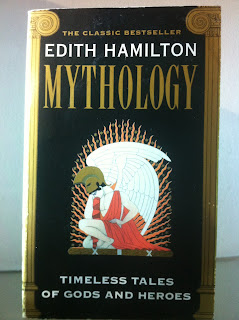Mythology By Edith Hamilton
To retell tales to the point of summing up the mythology of a civilisation is no mean feat. Edith Hamilton does complete justice to the subject which is evident in the way she puts together the disjoint tales, drawing upon the work of dramatists of later ages to straighten out a tale crudely rendered at the hands of the authors gone before. But, what struck me were the parallels that stand out so clearly between Indian and Greek mythic tales. Although the characterisation is distinct, the turnkey events bear startling similarities. Achilles’ heels are as vulnerable as Krishna’s. A lover going down to Hades to reclaim the life of the beloved is a Greek version of Savitri and Satyvan.
But, unlike the Greek gods, the Indian gods are more rational. The Indian god Indra is notorious for his promiscuity, but there is no philanderer like Zeus. A Greek god doesn't give two hoots about his godly demeanour when favouring his subject or venting his anger on a hero who has wronged him unknowingly. His wrath is waiting to be triggered and poop out the hero at sea. The Greek characters are free from moral baggage and full of caprice. The war ensuing the abduction of Helen (she is happy with her abduction like Rukmini) is a war of egos. While the war following Sita’s abduction upholds the principle of righteousness. Greek poets cringe at the idea of furnishing a tale of ethical choices.
Mythology is a factory of gods and heroes. For an age that was still grappling with the mystery surrounding them, its understanding of the world was through allegories. It is obvious that the earth and the sky became parent gods and their commerce bore numerous children. When gods proliferated, their dominions were narrowed down to an ivy or a pond.
Allegory was strengthened by inference. These metaphors also extended to human faculties and gods were forged even out of them. Odin, the supreme god of the Norse, is kept informed by the Thought and Memory gods. It is difficult to determine whether symbols are primary or secondary to the thing symbolised. In his book On Heroes and Hero Worship, Thomas Carlyle opines that only after the thing symbolised enters the human conception, does the symbol take its birth. Language has its limitation; the mythical tales may have made a deep sense to those who spoke and heard them first-hand. People, then, must have bowed to the compelling appeal of these myths and felt that the truth is secure in the mythic tradition. We now only appreciate them as the first gleams of human knowledge from hoary antiquity; the naive utterances of a tottering humanity.
Those who love stories for their own sake and want to acquaint themselves with Greek, Roman, and Norse mythologies which are alluded to in numerous works of literature, the book is definitely worth reading. A serious reading or a second read should help you remember the characters and the stories they occur in.
My rating: 9/10

Comments